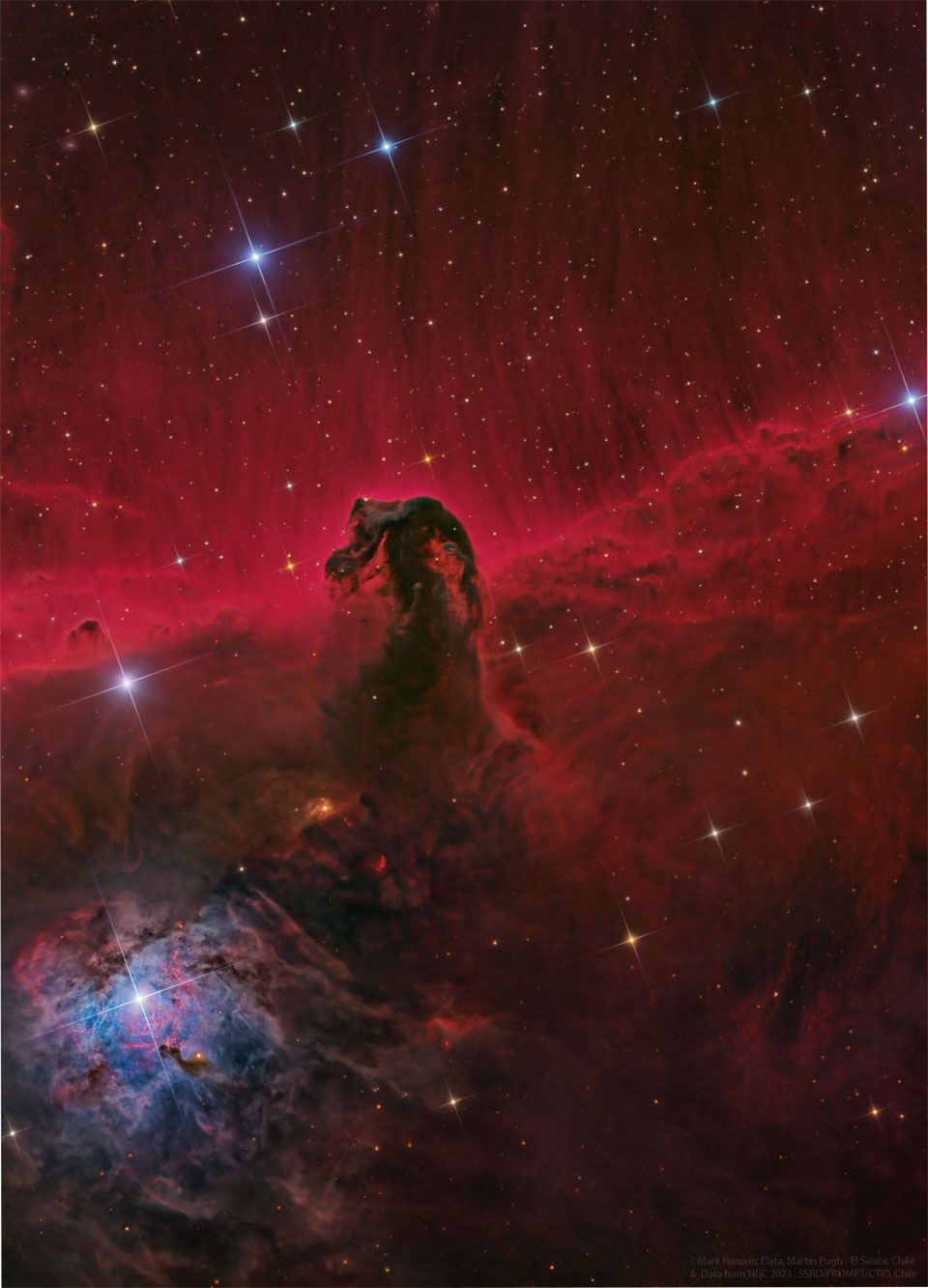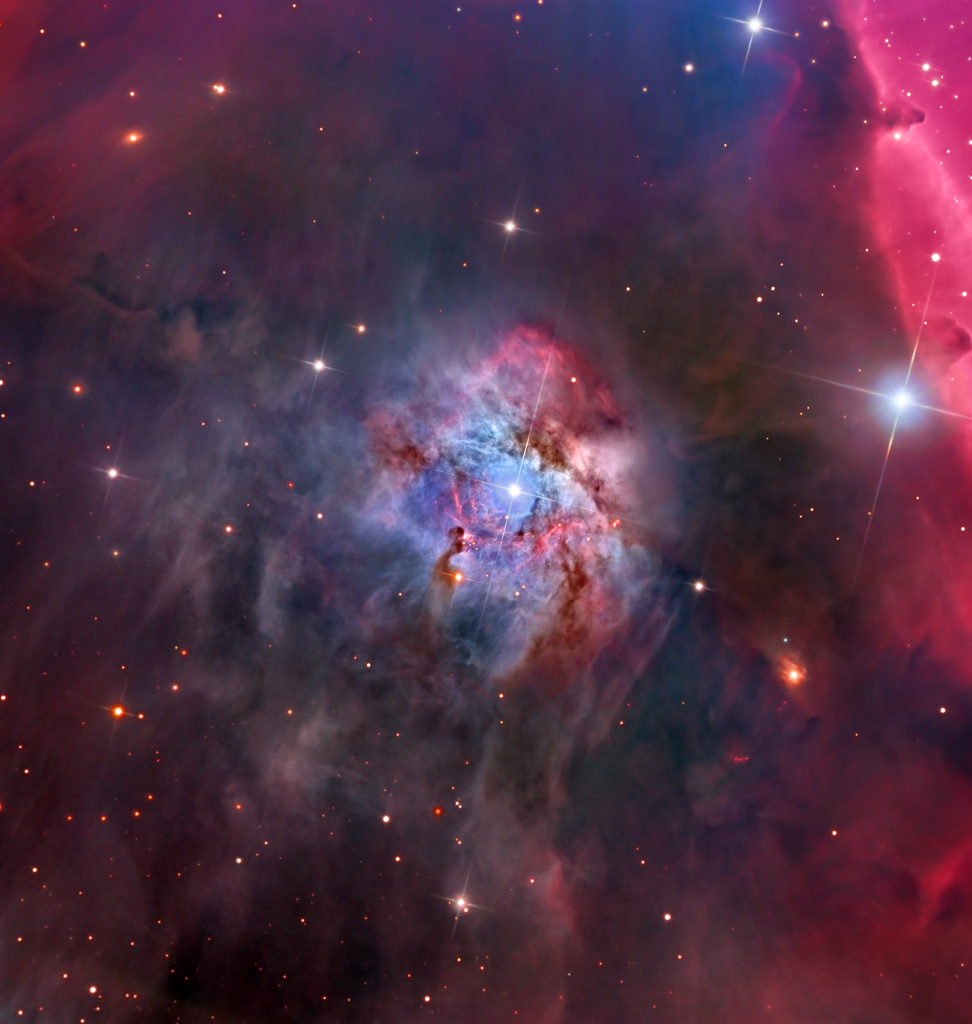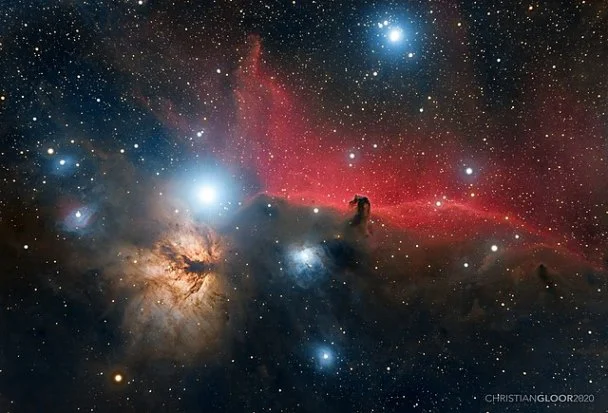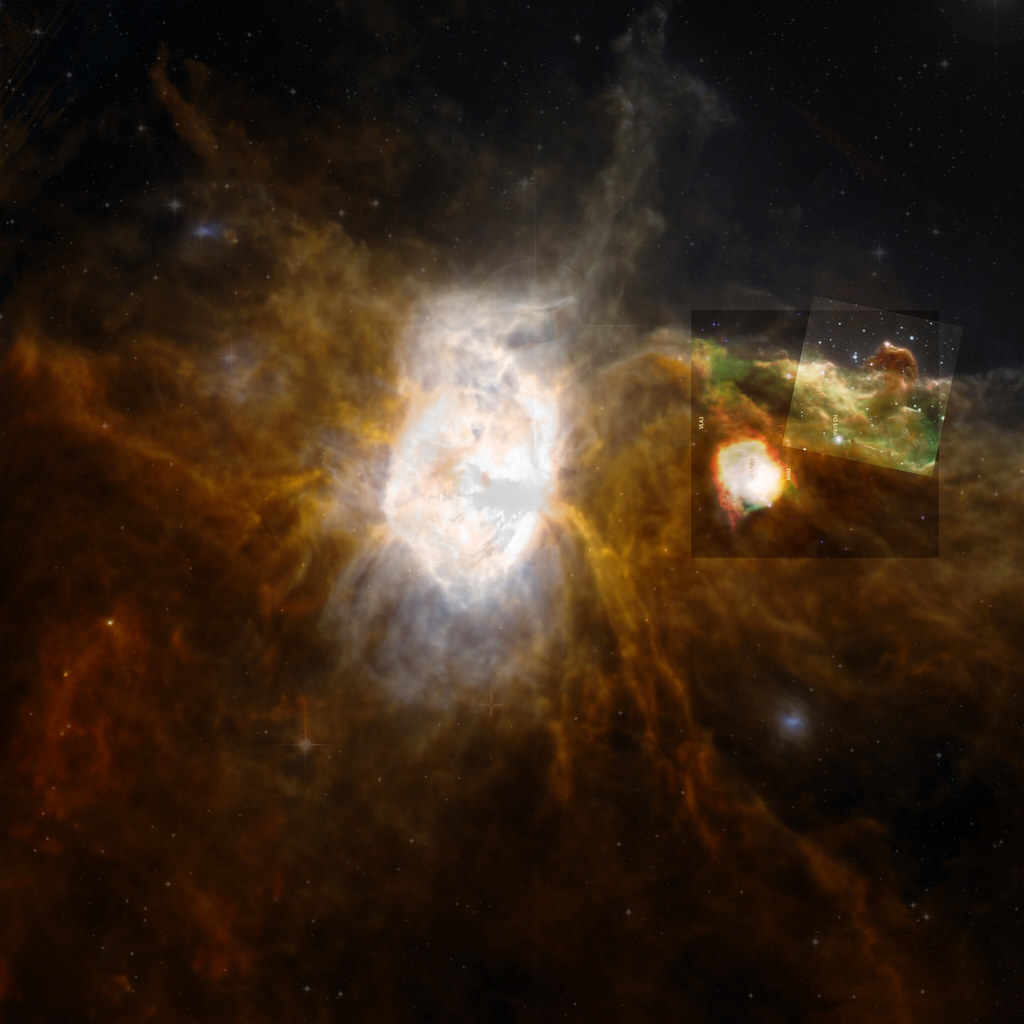Page 1 of 1
APOD: The Horsehead Nebula (2023 Nov 20)
Posted: Mon Nov 20, 2023 5:05 am
by APOD Robot
 The Horsehead Nebula
Explanation: Sculpted by
The Horsehead Nebula
Explanation: Sculpted by stellar winds and radiation, a magnificent interstellar dust cloud by chance has assumed this
recognizable shape. Fittingly named the
Horsehead Nebula, it is some 1,500 light-years
distant, embedded in the vast
Orion cloud complex. About five light-years "tall," the dark cloud is cataloged as
Barnard 33 and is visible only because its
obscuring dust is silhouetted against the glowing red emission nebula IC 434.
Stars are forming within the dark cloud.
Contrasting blue reflection nebula NGC 2023, surrounding a hot, young
star, is at the lower left of
the full image. The featured gorgeous
color image combines both
narrowband and
broadband images recorded using several different telescopes.
Re: APOD: The Horsehead Nebula (2023 Nov 20)
Posted: Mon Nov 20, 2023 6:17 am
by Ann
The Horsehead Nebula is one of the most well-known and most frequently photographed deep-sky objects out there, so for me it is getting a bit old. But there is a lot to see in today's APOD:
The Horsehead Nebula has formed because there is a brilliant O-type star, Sigma Orionis, located close to a molecular ridge, and the brunt of the ultraviolet light from Sigma Orionis is bearing down on the ridge, ionizing it but also evaporating it.
The Horsehead Nebula is a pillar, the same type of object as the famous Pillars of Creation. Both the Horsehead Nebula and the Pillars of Creation have been formed in the same way, when ultraviolet light from very hot stars ionizes but also evaporates gas structures. The densest gas structures remain standing the longest.
Herbig-Haro objects are created by stars in the process of forming. As they accrete matter, they eject jets.
As for NGC 2023, it is a beautiful reflection/emission nebula (mostly a reflection nebula really) surrounding a newborn star of spectral class B3:
Note that the red background of the Horsehead Nebula is very red. The nearby Flame Nebula, which is a combined emission nebula ionized by brilliant O-type star Alnitak and a molecular cloud, the birth site of an unborn cluster of baby stars, is very yellow by comparison.
Ann
Re: APOD: The Horsehead Nebula (2023 Nov 20)
Posted: Mon Nov 20, 2023 12:39 pm
by Christian G.
We've heard the Moonlight Sonata or seen the Girl with a Pearl Earring a zillion times but that doesn't take away their beauty! A dark horse head against a deep red background is an utmost stunning sight… One has to imagine seeing this for the very first time to be stunned over and over again (plus the thing is five light-years tall!)
Re: APOD: The Horsehead Nebula (2023 Nov 20)
Posted: Mon Nov 20, 2023 2:08 pm
by Chris Peterson
As always, I need to point out that the head is not the featured part of the horse's anatomy in this nebula.
_

- hh-ass.jpg (19.54 KiB) Viewed 9581 times
Re: APOD: The Horsehead Nebula (2023 Nov 20)
Posted: Mon Nov 20, 2023 4:18 pm
by orin stepanek
IC 434(HORSEHEAD NEBULA) AND NGC 2023
Aw! poor kitty
Re: APOD: The Horsehead Nebula (2023 Nov 20)
Posted: Mon Nov 20, 2023 5:44 pm
by George
Re Ann's comment: "The Horsehead Nebula has formed because there is a brilliant O-type star, Sigma Orionis, located close to a molecular ridge, and the brunt of the ultraviolet light from Sigma Orionis is bearing down on the ridge, ionizing it but also evaporating it."
I don't see how interstellar "gas" can "evaporate."
Liquids can evaporate to form a gas, and solids can sublimate to forma a gas, but once a gas is a gas, it can't evaporate further/again.
Re: APOD: The Horsehead Nebula (2023 Nov 20)
Posted: Mon Nov 20, 2023 5:55 pm
by Chris Peterson
George wrote: ↑Mon Nov 20, 2023 5:44 pm
Re Ann's comment: "The Horsehead Nebula has formed because there is a brilliant O-type star, Sigma Orionis, located close to a molecular ridge, and the brunt of the ultraviolet light from Sigma Orionis is bearing down on the ridge, ionizing it but also evaporating it."
I don't see how interstellar "gas" can "evaporate."
Liquids can evaporate to form a gas, and solids can sublimate to forma a gas, but once a gas is a gas, it can't evaporate further/again.
"Evaporate" is synonymous with "disperse" in this context.
Re: APOD: The Horsehead Nebula (2023 Nov 20)
Posted: Mon Nov 20, 2023 9:39 pm
by johnnydeep
Despite the title of this APOD, I think NGC 2023 is the real star of this show. Also, I think it is noteworthy how similar to this image from Mark Hanson is the image from Ken Crawford seen here
http://www.imagingdeepsky.com/Nebulae/H ... sehead.htm, though this APOD is nicer and has a slightly larger FOV. But I guess that's just because the Horsehead / NGC 2023 pair are so photogenic!
Re: APOD: The Horsehead Nebula (2023 Nov 20)
Posted: Tue Nov 21, 2023 5:45 am
by AVAO
johnnydeep wrote: ↑Mon Nov 20, 2023 9:39 pm
Despite the title of this APOD, I think NGC 2023 is the real star of this show. Also, I think it is noteworthy how similar to this image from Mark Hanson is the image from Ken Crawford seen here
http://www.imagingdeepsky.com/Nebulae/H ... sehead.htm, though this APOD is nicer and has a slightly larger FOV. But I guess that's just because the Horsehead / NGC 2023 pair are so photogenic!
I think that this cosmic region is also very photogenic in IR.
Maybe JWST should also take a look here in the future
 Image Source: Herschel / Original data: NASA/ESA
False colors composit Euclid/ods / Original data: NASA/ESA
NGC 2023 False colors composit Euclid /ods / Original data: NASA/ESA
Image Source: Herschel / Original data: NASA/ESA
False colors composit Euclid/ods / Original data: NASA/ESA
NGC 2023 False colors composit Euclid /ods / Original data: NASA/ESA
Re: APOD: The Horsehead Nebula (2023 Nov 20)
Posted: Tue Nov 21, 2023 2:42 pm
by johnnydeep
AVAO wrote: ↑Tue Nov 21, 2023 5:45 am
johnnydeep wrote: ↑Mon Nov 20, 2023 9:39 pm
Despite the title of this APOD, I think NGC 2023 is the real star of this show. Also, I think it is noteworthy how similar to this image from Mark Hanson is the image from Ken Crawford seen here
http://www.imagingdeepsky.com/Nebulae/H ... sehead.htm, though this APOD is nicer and has a slightly larger FOV. But I guess that's just because the Horsehead / NGC 2023 pair are so photogenic!
I think that this cosmic region is also very photogenic in IR.
Maybe JWST should also take a look here in the future
 Image Source: Herschel / Original data: NASA/ESA
Image Source: Herschel / Original data: NASA/ESA
...
Wow - that makes it look like the Flame Nebula extends all the way to the Horsehead!
 The Horsehead Nebula
The Horsehead Nebula









